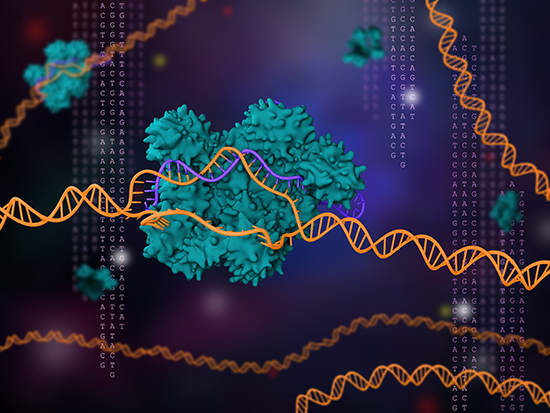
Highlighting the need to monitor patients who have undergone CRISPR-Cas9-based gene therapy for cancer-related mutations, researchers at Sanford Burnham Prebys have shown that gene editing, specifically gene knockout (KO) using CRISPR-Cas9 technology, can favor cells with mutated forms of p53 or KRAS genes linked to cancer.
“Our study shows that in many different cell types, CRISPR gene-editing can confer a selective advantage to cells harboring mutations in genes associated with cancer, such as p53 and KRAS,” said co-senior author Ani Deshpande, Ph.D., an assistant professor in the NCI-Designated Cancer Center at Sanford Burnham Prebys. “We have shown that when CRISPR-Cas9 is used to edit the genome, cells with cancer-associated mutations are likely to be selected to survive—and this is more widespread than scientists previously understood.”
Deshpande and colleagues reported on their studies in Nature Communications, in a paper titled, “A systematic genome-wide mapping of oncogenic mutation selection during CRISPR-Cas9 genome editing.”
CRISPR-Cas9 works by creating double-stranded DNA breaks at specific points in a DNA sequence, allowing scientists to target and edit specific genes. The technology is used widely for biological research. However, as the authors noted, “Beyond its impact on biological research, CRISPR-based approaches have been considered for various applications in medicine, from reparative editing of primary cells to the development of new strategies to treat a variety of genetic diseases, including cancer.”
However, clinical trials based on CRISPR technology have been deferred due to potential risks, such as off-target effects, or the creation of unexpected changes to chromosomes, or immunogenicity concerns. “Other studies have demonstrated that double-stranded breaks (DSBs) induced during CRISPR-Cas9-based gene knockout (CRISPR-KO) can lead to DNA damage response, whose level can either be associated with the copy number of the targeted gene or in some cases structural rearrangements in the region,” the team continued.
The p53 gene stops cell division if a genomic error arises and attempts to correct the problem. If the error cannot be fixed, p53 will initiate programmed cell death before the cells can become cancerous. This makes p53 a critical anti-cancer gene and losing its function can make people more susceptible to tumors. “The p53 gene is so important that it’s actually nicknamed the ‘guardian of the genome,’” said Deshpande. The p53 gene responds to double-stranded breaks (DSBs) by arresting cell growth, which means that cells that have undergone CRISPR would grow and divide less effectively. However, this also means that cells with pre-existing mutations in the p53 gene can continue to grow and divide normally, giving them a competitive advantage.
Prior studies have indicated that CRISPR-Cas9 genome editing may select for p53-mutated cells, but questions still remain. For their newly reported research, the investigators used an integrated computational and experimental approach to systematically evaluate each cancer driver mutation selection associated with CRISPR-Cas9. Computational biologists headed by research co-lead Eytan Ruppin, PhD, chief of the Cancer Data Science Laboratory at the NCI Center for Cancer Research, analysed p53 responses to double-stranded breaks in nearly 1,000 human cell lines.
In almost every cell type, they found that after CRISPR-Cas9 KO, cells with normal p53 genes exhibited slower growth, while those with mutated p53 genes were less affected, allowing them to grow faster and outcompete the normal cells. They also found that CRISPR may confer an advantage to cells with other cancer-associated mutations, such as those of the KRAS oncogene. “We first confirm the previous findings of the selection for pre-existing p53 mutations by CRISPR-Cas9,” the scientists stated. “We next demonstrate that similar to p53, wildtype KRAS may also hamper the growth of Cas9-edited cells, potentially conferring a selective advantage to pre-existing KRAS-mutant cells.”
“This is not the first time researchers have shown CRISPR may introduce potentially dangerous changes,” said Ruppin, “However, it is the first time these effects have been demonstrated in so many diverse cells. The findings point to a need for caution in the use of CRISPR-based gene therapies, particularly when treating individuals with underlying mutations in p53 or KRAS genes.
The authors concluded, “The selection for pre-existing p53 or KRAS mutations may confound CRISPR-Cas9 screens in cancer cells and more importantly, calls for monitoring patients undergoing CRISPR-Cas9-based editing for clinical therapeutics for pre-existing p53 and KRAS mutations.”
“There are CRISPR therapies being developed to correct mutations in many human tissues, but as others have noted before, we need to proceed with caution, because we may be selecting for cells that carry mutations in key cancer driver genes when using CRISPR-Cas9 editing, and that could be potentially dangerous,” Ruppin noted. “However, fortunately and importantly, additional new CRISPR editing techniques that have been recently developed are much less likely to carry this risk, if at all.”
“Early CRISPR techniques generated double-stranded breaks, but more modern iterations make simpler edits to target DNA,” Deshpande commented further. “If we use a non-cutting version of CRISPR we are likely to avoid many of these problems, which could be very good news for patients.”













